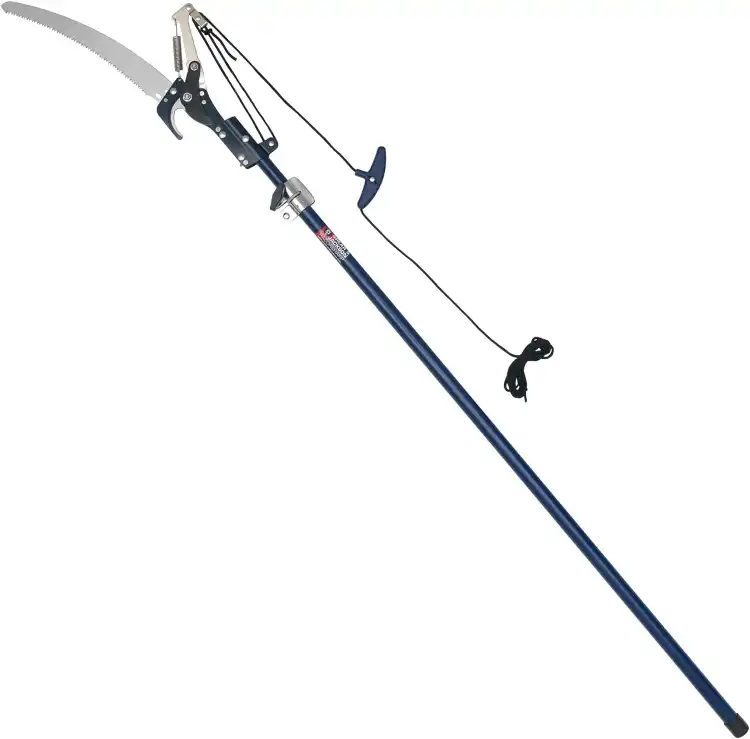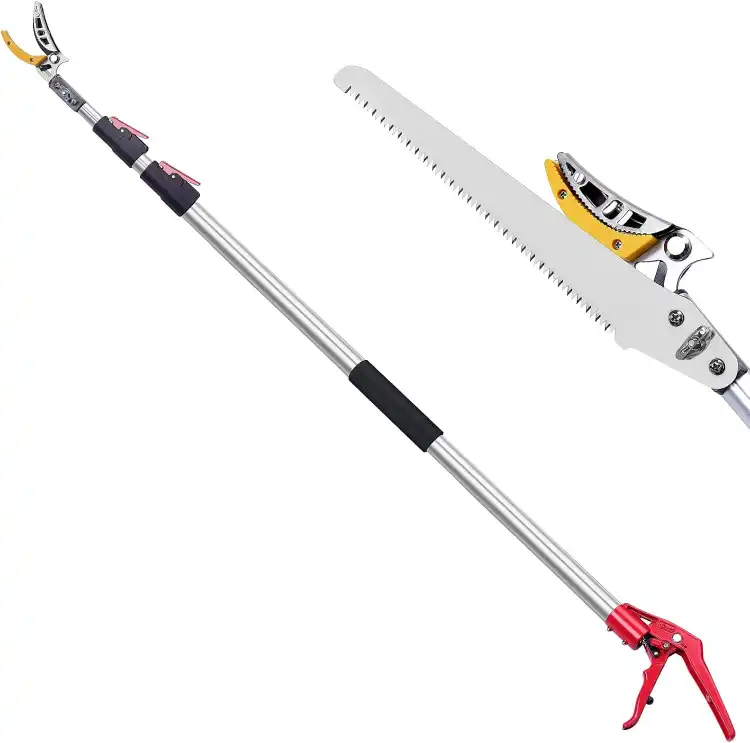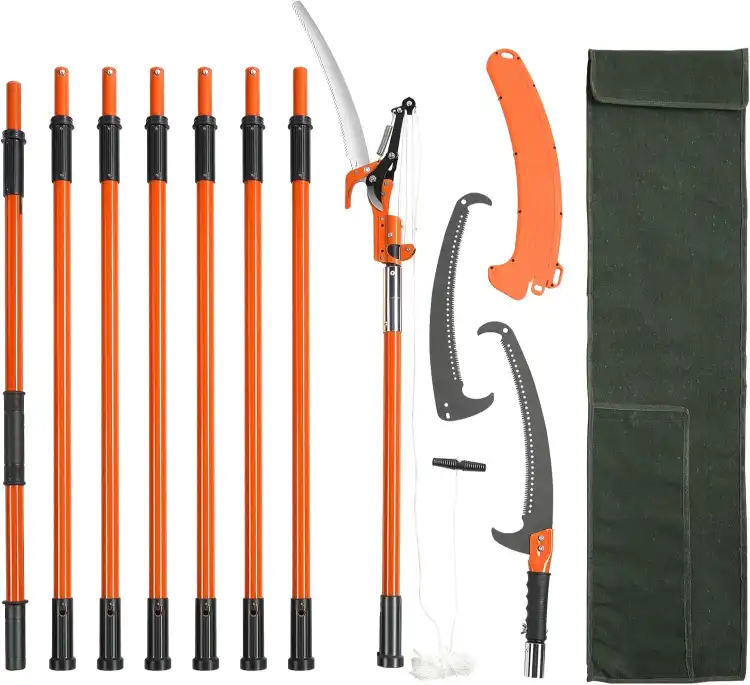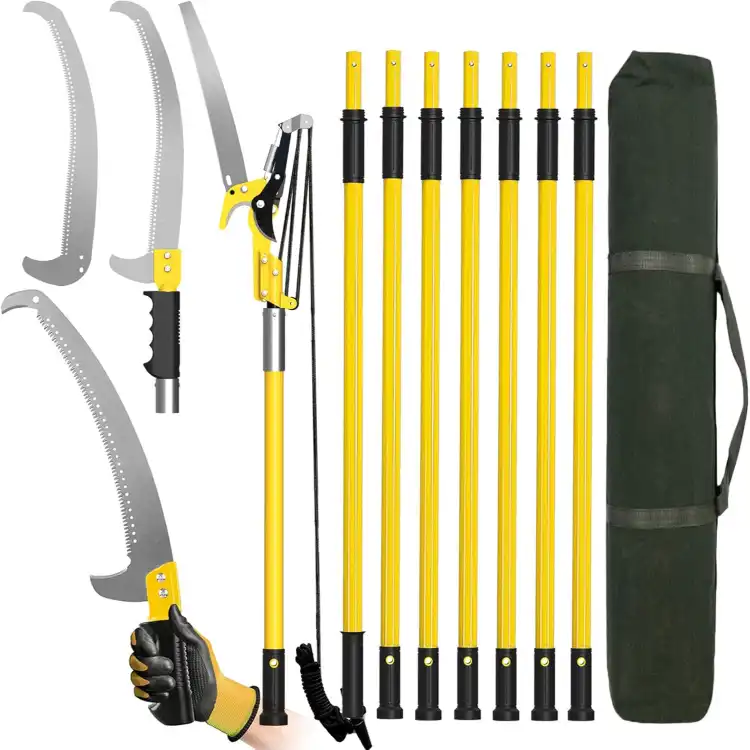Tree pruning is a fundamental aspect of maintaining the health and aesthetics of trees. It involves the careful removal of certain parts of a tree, such as branches, buds, or roots, that are not contributing to the tree’s overall health or appearance. Pruning is not just about making a tree look good; it’s about ensuring the tree’s longevity and vitality.
Pruning is an essential part of tree care that can significantly impact the lifespan and health of your trees. It helps to prevent disease, promote growth, and enhance the overall appearance of the tree. However, to effectively prune a tree, one needs the right tools, and that’s where a tree pruner comes in.
A tree pruner plays a crucial role in maintaining tree health. It is a tool designed to cut through branches, twigs, and leaves with precision and ease. With a tree pruner, you can reach high branches without the need for a ladder, making the pruning process safer and more efficient.
Our Top Tree Pruner Picks

Spear & Jackson 4930FZ Razorsharp Telescopic Tree Pruner
Check on AmazonKey Specs:
- Blade Material: SK5 Carbon Steel
- Handle Length: Extends up to 92 inches
- Lopper Capacity: Cuts branches up to 1.2″ in diameter
- Saw Blade Length: 13 inches
- Warranty: 10-year guarantee
The Spear & Jackson 4930FZ Razorsharp Telescopic Tree Pruner is a must-have for gardeners needing precision and power. With its extendable handle reaching up to 92 inches, I can easily tackle high branches without using a ladder. The carbon steel blade stays sharp longer, making quick work of cutting thicker branches (up to 1.2″). The pull cord lopper is perfect for light trimming, while the 13-inch saw blade handles heavy-duty cutting. It’s a solid, reliable tool for maintaining trees and shrubs.

Fiskars 7ft-14ft Power-Lever Extendable Pole Saw and Tree Pruner
Check on AmazonKey Specs:
- Pole Length: Extends from 7 to 14 feet
- Blade Material: High-speed steel
- Saw Blade Length: 15 inches
- Pruner Capacity: Cuts branches up to 1 1/8″
- Warranty: Lifetime warranty
The Fiskars 7ft-14ft Power-Lever Extendable Pole Saw and Tree Pruner offers both precision and power, making it ideal for maintaining your yard. The Power-Lever technology amplifies cutting force, ensuring effortless cuts, while the 15-inch WoodZig saw with aggressive teeth tackles thicker branches. The fiberglass pole is lightweight yet strong, with a secure double locking system for stability. Its high-speed steel pruner remains sharp even through tough use, offering durability and longevity. Perfect for high branches and easy access without a ladder.

FLORA GUARD 4.6-10ft Extendable Tree Pruner
Check on AmazonKey Specs:
- Blade Material: High-carbon steel
- Saw Blade Length: 12 inches
- Telescopic Length: 4.6 to 10 feet
- Cutting Capacity: Up to 1/2 inch for pruner, 8-inch for saw
- Weight: 3.4 pounds
The FLORA GUARD 4.6-10ft Extendable Tree Pruner is a versatile, lightweight tool designed for effortless garden and orchard maintenance. With a high-carbon steel blade and a 12-inch saw, it cuts through branches up to 8 inches in diameter. The adjustable length extends from 4.6 to 10 feet, making it perfect for reaching high branches without a ladder. The SK5 steel blade with a 23° cutting angle offers exceptional durability, and the tool is easy to handle thanks to its lightweight aluminum alloy construction.

VEVOR Manual Pole Saw, 7.3-27 ft Extendable Tree Pruner
Check on AmazonKey Specs:
- Blade Material: Alloy steel with Teflon coating
- Telescopic Length: 7.3 to 27 feet
- Weight: 11 lbs (5.1 kg)
- Blade Thickness: 1.2 mm (0.05 inches)
- Cutting Features: Hook knife for easy twig and branch removal
The VEVOR Manual Pole Saw is a powerful and versatile tool designed for cutting high and low branches with ease. With an extendable pole ranging from 7.3 to 27 feet, it allows you to reach even the highest branches without a ladder. The alloy steel blade is durable, rust-proof, and equipped with a Teflon coating for smooth cuts. Its double-lock design ensures stability, while the insulated handles provide safety during use. It’s lightweight yet strong, making it perfect for long hours of trimming.

Dremmt 27 FT Pole Saws for Tree Trimming, [Ultra Sturdy] Tree Pruner
Check on AmazonKey Specs:
- Blade Material: Carbon steel with Teflon coating
- Telescopic Length: 7.3 to 27 feet
- Weight: 9 lbs
- Cutting Diameter: Scissors cut up to 35mm
- Rope Length: 19 feet (5.8 meters) composite nylon rope with pulley system
The Dremmt 27 FT Pole Saw is an exceptional tool designed for safe and efficient tree trimming. With a dual-locking design, it provides unmatched stability, ensuring no loosening or shaking during use. The carbon steel blade is thickened and Teflon-coated, enhancing its durability and cutting power, while the curved saw blade improves cutting efficiency by 50%. The added SK5 steel scissors with a pulley system allow for effortless cutting of branches up to 35mm in diameter. This versatile tool is lightweight yet strong, offering excellent performance for both high and low pruning tasks.
Understanding Tree Pruning
The science behind tree pruning is quite fascinating. It involves understanding the growth patterns of trees, their response to cutting, and the best time to prune. When you cut a branch off a tree, the tree forms a special type of tissue known as a callus. This callus grows over the wound to protect the tree from disease and pests. Pruning at the right time and in the right way ensures that this callus formation is optimal.
Tree pruning is not just about cutting off branches; it’s about making strategic cuts that improve the tree’s health and structure. Proper pruning can help prevent diseases and pests, improve fruit production for fruit trees, and enhance a tree’s physical appearance. It also helps to prevent potential safety hazards, such as falling branches.
Regular tree pruning has numerous benefits. It helps to improve the health of the tree by removing dead or diseased branches. It also helps to shape the tree and control its size, making it a crucial part of landscaping. Moreover, regular pruning can increase sun exposure and air circulation throughout the tree and underlying landscape, which can improve the tree’s health and vitality.
The Need for a Tree Pruner
A tree pruner is a tool that makes the task of pruning trees more manageable. It works by having a blade that you can control through a string or lever. This blade can cut through branches, allowing you to prune your trees effectively. Some tree pruners also have telescopic handles, which means you can extend the handle to reach higher branches.
Having a tree pruner can make a significant difference in your tree pruning tasks. It allows you to reach branches that would be difficult to reach otherwise. It also provides a safer way to prune trees as you can maintain a safe distance from the branches you are cutting. Moreover, a tree pruner can give you more control over the pruning process, allowing you to make precise cuts.
There are several advantages to owning a tree pruner. For one, it makes the task of pruning trees much easier and more efficient. It also allows for precision in pruning, which can greatly improve the health and appearance of your trees. Additionally, using a tree pruner can reduce the risk of injury from falling branches or from climbing trees or ladders.
Types of Tree Pruners
There are several types of tree pruners available on the market, each designed for a specific type of pruning task. Pole pruners, for instance, are ideal for pruning branches that are high up in the tree. They have a long handle, often extendable, and a blade at the end that can be controlled using a string or lever.
Hand pruners, on the other hand, are perfect for smaller pruning tasks. They are handheld tools that look similar to scissors and are ideal for cutting smaller branches and twigs. Hand pruners are available in different designs, including bypass, anvil, and ratchet, each offering unique advantages.
Loppers are another type of tree pruner. They are essentially long-handled hand pruners that provide more leverage, making it easier to cut through thicker branches. They are perfect for pruning branches that are too thick for hand pruners but too thin for a pruning saw.
Pruning saws are designed for cutting through thick branches. They have a curved blade with sharp teeth that can cut through wood efficiently. Pruning saws are ideal for heavy-duty pruning tasks that other types of pruners can’t handle.
Factors to Consider When Buying a Tree Pruner
When buying a tree pruner, there are several factors you need to consider. The size and type of trees you have in your yard is one of the most important factors. Different types of pruners are suitable for different types of trees and branches. For instance, if you have large trees with thick branches, you might need a pruning saw or a lopper. On the other hand, if you have smaller trees with thin branches, a hand pruner might be sufficient.
The height of the trees is another crucial factor. If you have tall trees, you might need a pole pruner with an extendable handle to reach the high branches. On the other hand, if your trees are relatively short, a hand pruner or a lopper might be enough.
Your physical capabilities and comfort should also be considered when buying a tree pruner. Pruning can be a physically demanding task, especially when dealing with large trees. Therefore, you should choose a pruner that you are comfortable using. Consider the weight of the pruner, the grip of the handle, and whether it has features like an extendable handle or a rotating head for easier use.
Detailed Guide to Choosing a Tree Pruner
Choosing a tree pruner involves understanding the different features that a pruner can have and how they can benefit you. For instance, some pruners have an extendable handle, which can be very useful for reaching high branches. Some have a rotating head, which can make it easier to cut at different angles. Others have a ratchet mechanism, which can make cutting through thick branches easier.
The quality of the blade is another important factor to consider when choosing a tree pruner. The blade should be made of high-quality material, such as carbon steel, and should be sharp enough to make clean cuts. A dull or poor-quality blade can damage the tree and make the pruning process more difficult.
The handle length and design can also impact the ease of use and effectiveness of the tree pruner. A longer handle allows you to reach higher branches, while a shorter handle might provide more control. The design of the handle, such as whether it has a non-slip grip, can also affect your comfort and safety while pruning.
Safety Measures When Using a Tree Pruner
When using a tree pruner, it’s important to follow certain safety measures. Proper handling and use of the pruner are crucial to prevent accidents. Always hold the pruner firmly and use both hands when making a cut. Avoid overreaching or using the pruner in unstable positions. Also, make sure to keep the pruner’s blade away from your body and other people.
Using protective gear is another important safety measure when using a tree pruner. This can include safety glasses to protect your eyes from flying debris, gloves to protect your hands, and sturdy shoes to protect your feet. If you’re using a pole pruner, a hard hat might also be necessary to protect your head from falling branches.
Lastly, it’s important to inspect the tree pruner before use. Check the blade for sharpness and ensure that all parts are functioning properly. A malfunctioning pruner can be a safety hazard, so it’s important to keep it in good working condition.
Maintenance and Care for Tree Pruners
Proper maintenance and care for your tree pruner can extend its lifespan and ensure its effectiveness. This includes cleaning the pruner after each use to remove sap and other debris from the blade. Storing the pruner in a dry place can also prevent rust and other damage.
Sharpening your tree pruner is also an important part of its maintenance. A sharp blade makes cleaner cuts, which are healthier for the tree and easier for you. The frequency of sharpening depends on how often you use the pruner and the type of material you’re cutting. As a general rule, you should sharpen the blade whenever it starts to feel dull or when it starts to pull or tear the wood instead of cutting it cleanly.
When sharpening your tree pruner, it’s important to follow the correct technique. This usually involves using a file or sharpening stone and following the angle of the cutting edge. Always make sure to protect your hands with gloves when sharpening the blade.
Top Tree Pruner Brands to Consider
There are several top-rated tree pruner brands that you might want to consider. Fiskars, for instance, is a well-known brand that offers a variety of tree pruners, from hand pruners to pole pruners. Their pruners are known for their quality, durability, and innovative features.
Corona is another reputable brand that offers high-quality tree pruners. Their pruners are known for their sharp blades and comfortable handles. They offer a variety of pruners, including hand pruners, loppers, and pruning saws.
Each brand has its pros and cons. For instance, Fiskars pruners are often praised for their durability and ease of use, but they can be more expensive than other brands. On the other hand, Corona pruners are known for their quality and affordability, but some users find their pruners to be heavier than others. Therefore, it’s important to consider your specific needs and preferences when choosing a brand.
Conclusion
Choosing the right tree pruner is crucial for maintaining the health and appearance of your trees. The right pruner can make the task of pruning much easier and more efficient, and can help ensure the longevity and vitality of your trees.
There are several factors to consider when choosing a tree pruner, including the type and size of your trees, the height of the branches, and your physical capabilities and comfort. Understanding the different features of a tree pruner, such as the blade quality and handle design, can also help you make an informed decision.
In conclusion, tree pruning is an essential part of tree care, and having the right tool can make a significant difference. With the right tree pruner, you can ensure the health and beauty of your trees and make the task of pruning easier and safer.
FAQs
How often should I sharpen my tree pruner?
The frequency of sharpening depends on how often you use the pruner and the type of material you’re cutting. As a general rule, you should sharpen the blade whenever it starts to feel dull or when it starts to pull or tear the wood instead of cutting it cleanly.
What safety gear should I use when pruning trees?
When pruning trees, it’s important to use safety glasses to protect your eyes from flying debris, gloves to protect your hands, and sturdy shoes to protect your feet. If you’re using a pole pruner, a hard hat might also be necessary to protect your head from falling branches.
What’s the difference between a pole pruner and a hand pruner?
A pole pruner has a long handle, often extendable, and is ideal for pruning branches that are high up in the tree. A hand pruner, on the other hand, is a handheld tool that is ideal for cutting smaller branches and twigs.
